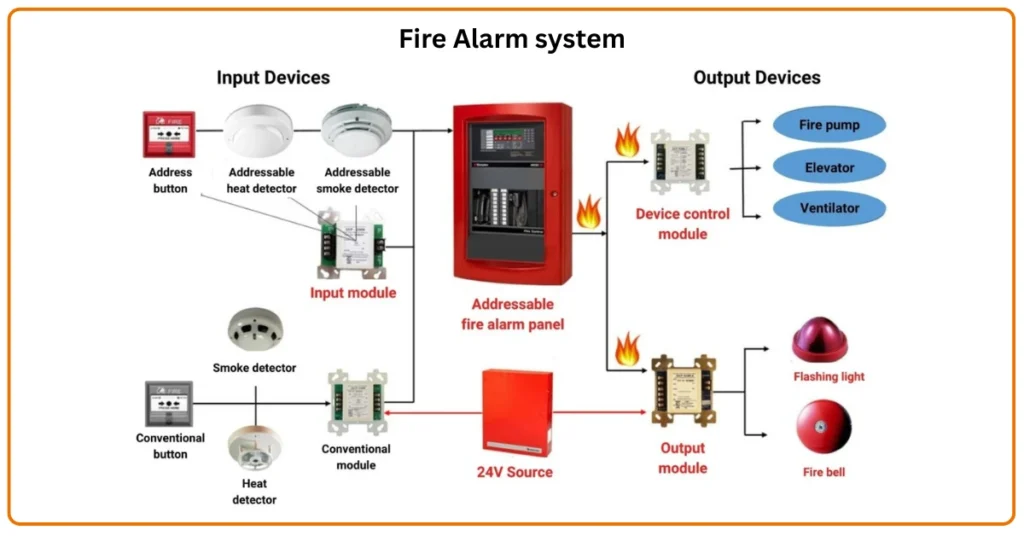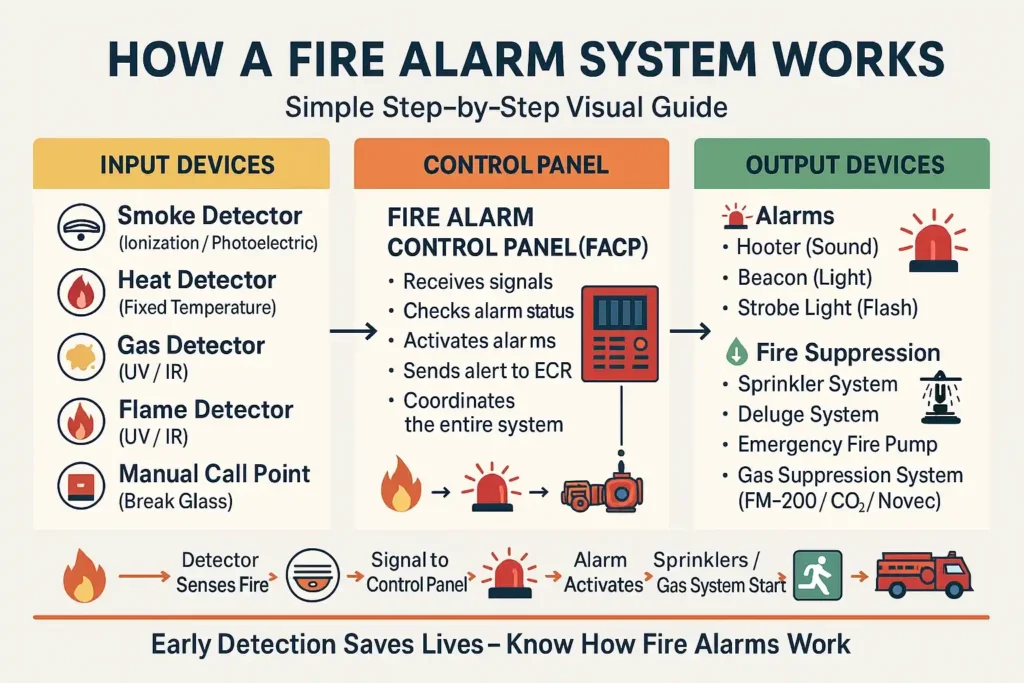Table of Contents
ToggleFire accidents can happen anywhere, homes, offices, factories, schools, or even shopping malls.
When a fire starts, every second is important. A small spark can turn into a huge fire in just a few minutes. That is why almost every building has a fire alarm system.
The main purpose of a fire alarm system is very simple:
1) Detect the fire early
2) Warn people inside the building
3) Help start fire-fighting actions quickly
In this article you will learn how a fire alarm system works in automation, what devices it uses, and why they are important.
What Is a Fire Alarm System?
A fire alarm system is a safety system designed to sense fire, warn people, and help control the fire.
It protects both:
1) Life (people who need to evacuate)
2) Property (building, equipment, and belongings)
When the system detects fire, it:
1) Sends signals to a control panel
2) Turns on alarms
3) Activates fire-fighting systems (sprinklers, suppression gas, etc.)
4) Notifies the fire service or remote monitoring center (ECR)
So the goal is simple: detect, warn, and respond.

Main Parts of a Fire Alarm System
A fire alarm system works using three main parts:
1. Input Devices (Fire Detectors)
These sense the fire, smoke, heat, gas, or flames.
2. Control Panel (Brain of the System)
This receives signals, decides what action to take, and sends commands.
3. Output Devices (Alarm & Fire Suppression)
These warn people or control the fire.
Let us understand each of these in detail.
A) Input Devices – How the System Detects Fire
Input devices are the sensors that detect any sign of fire. These include smoke, heat, flame, and gas detectors. Each detector works differently.
1 Smoke Detectors
Smoke detectors sense smoke in the air. Smoke is usually the first sign of a fire.
There are two main types of smoke detectors:
a) Ionization Smoke Detector
- Contains a tiny amount of radioactive material
- Creates ions between two electrodes
- When smoke enters, it disturbs the ions
- The detector senses this disturbance and triggers the alarm
1) Best for fast-burning fires with flames
2) Very sensitive to small smoke particles
b) Photoelectric Smoke Detector
- Contains a light beam and a photocell
- Under normal conditions, the light reaches the sensor properly
- When smoke enters the chamber, the light beam gets scattered or blocked
- This change activates the alarm
1) Best for slow, smoldering fires
2) More stable, fewer false alarms
2 Gas Detectors
When materials burn, they release gases.
Gas detectors sense these fire-related gases.
Some gas detectors can also detect:
- Flammable gases
- Explosive vapors
- Toxic gases
This allows the fire system to alert people even before a fire starts, which helps prevent explosions in industries.
3 Flame Detectors
Used in high-risk locations like:
- Fuel storage areas
- Chemical plants
- Power plants
- Engine rooms
Flame detectors react very quickly.
There are two types:
a) Ultraviolet (UV) Flame Detector
- Detects UV radiation from flames
- Very fast response
- Good for detecting explosions and fast fires
b) Infrared (IR) Flame Detector
- Detects infrared light flickering from fire
- Useful for dusty or smoky environments
Some advanced detectors combine both UV and IR to avoid false alarms.
4 Heat Detectors
Heat detectors activate when the surrounding temperature rises above a preset limit.
There are three basic principles used:
Materials expand when heated
Some elements melt when exposed to high heat
Heated materials change their electric properties
Heat detectors are reliable in places like:
- Kitchens
- Workshops
- Storage rooms
- Areas with dust or fumes
Where smoke detectors may give false alarms, heat detectors work better.
5 Manual Call Point (Break Glass Unit)
Sometimes a person sees the fire before the sensors do.
In such cases, they can break the glass or press the button to manually trigger the alarm.
- Simple
- Fast
- Helps raise the alarm immediately
B) Control Panel – The Brain of the Fire Alarm System
The Fire Alarm Control Panel (FACP) is the most important part of the system.
It performs these functions:
- Receives signals from all detectors
- Checks if the signal is real or a false alarm
- Activates the alarm sounders and visual lights
- Starts fire suppression equipment
- Sends information to the Emergency Control Room (ECR)
- Shows the zone or room where the fire is detected
Modern control panels are:
- Smart
- Programmable
- Connected to remote monitoring centers
This helps fire departments respond faster.

C) Output Devices – How the System Warns People & Controls Fire
Output devices are the components that respond after a fire is detected.
They include alarms, sprinklers, gas systems, and emergency pumps.
1 Alarming Devices
a) Hooter (Sound Alarm)
Produces a loud siren sound to alert occupants.
b) Beacon (Flash Light)
Flashes visually to indicate danger.
c) Fire Alarm Flashlight / Strobe Light
Used in noisy environments or for people with hearing difficulties.
These devices help everyone identify the emergency quickly.
2 Fire Suppression Systems (Final Control Elements)
Once a fire is detected, the system should try to control it.
This is done by suppression devices.
1. Deluge Sprinkler System
- All sprinkler heads are always open
- When activated, water flows from every sprinkler together
- Used in high-hazard areas like chemical plants
2. Firewater Sprinkler System
The most common fire suppression system.
How it works:
- Water supply is stored or pumped
- Piping carries water across the building
- Each sprinkler head has a heat-sensitive element
- When heated, it opens and releases water
Only sprinklers near the fire operate
Helps control fire quickly
3. Emergency Fire Water Injection Pumps
Used when water comes from a tank or static source.
Job of the pump:
- Increase water flow
- Build pressure in pipes
- Supply high volumes of water to the firefighting network
Large pumps (2,500–5,000 gpm) are usually diesel-operated and critical for fire protection in industries handling flammable materials.
4. Fixed Fire Suppression Systems (Gas-Based)
Used in special areas where water is harmful, like:
- Server rooms
- Data centers
- Control rooms
- Electrical switchgear rooms
These systems release gases like:
- FM-200
- CO₂
- Novec 1230
The gas removes oxygen or interrupts the chemical reaction, stopping the fire quickly without damaging sensitive equipment.
What we learn today?
A fire alarm system is a safety setup that detects fire early, warns people, and helps control the situation before it becomes dangerous.
It uses different detectors like smoke, heat, gas, and flame sensors to identify any signs of fire.
These signals are sent to the Fire Alarm Control Panel, which then activates alarms, lights, and fire-fighting systems such as sprinklers or gas suppression units.
The system also alerts emergency teams so help can arrive quickly. By giving early warnings and starting automatic fire-fighting actions, a fire alarm system saves lives, protects property, and reduces fire damage.
I hope you like above blog. There is no cost associated in sharing the article in your social media. Thanks for Reading !! Happy Learning

